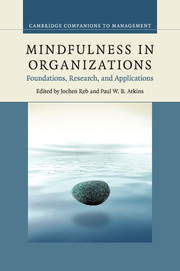Book contents
- Frontmatter
- Contents
- List of figures
- List of tables
- List of contributors
- Foreword
- Preface
- Part I Foundations
- 1 Introduction
- 2 What is mindfulness, and why should organizations care about it?
- 3 Mindfulness: historical and contemplative context and recent developments
- 4 Methods of mindfulness: how mindfulness is studied in the workplace
- 5 Applying mindfulness in the context of work: mindfulness-based interventions
- Part II Research
- Part III Applications
- Index
- References
2 - What is mindfulness, and why should organizations care about it?
from Part I - Foundations
Published online by Cambridge University Press: 05 July 2015
- Frontmatter
- Contents
- List of figures
- List of tables
- List of contributors
- Foreword
- Preface
- Part I Foundations
- 1 Introduction
- 2 What is mindfulness, and why should organizations care about it?
- 3 Mindfulness: historical and contemplative context and recent developments
- 4 Methods of mindfulness: how mindfulness is studied in the workplace
- 5 Applying mindfulness in the context of work: mindfulness-based interventions
- Part II Research
- Part III Applications
- Index
- References
Summary
Introduction
Mindfulness offers the potential to transform internal and external environments in a way that nurtures growth, emotional intelligence, creativity, innovation and the capacity to respond to life with an open mind and a wise heart. In business, mindfulness may confer powerful advantages. Research suggests that fear-based, top-down hierarchies inhibit creativity and innovation, whereas attuned, empathic, and spacious environments catalyze human capacity. The thoughtful incorporation of mindfulness into a professional culture can evolve a work environment toward a richer and more creative state, where one's “work” arises from a state of being rather than reactive doing. This chapter offers a brief overview of mindfulness and its applications in workplace settings. We review the literature and explore mechanisms of action for its beneficial effects. We propose specific pathways of integrating mindfulness, as a self-care practice as well as a way to cultivate professional effectiveness. Finally, we explore future directions of integrating mindfulness in organizational settings, offering our aspirations for the modern promise of this ancient tradition.
What is mindfulness?
Mindfulness is above all about presence. It is about inhabiting our lives fully, and bringing all of our awareness into the present moment. Mindfulness fundamentally is a way of being, a way of relating to experience, moment by moment. A simple, yet nuanced definition of mindfulness is “the awareness that arises through intentionally attending in an open, caring, and discerning way” (Shapiro and Carlson 2009). Mindfulness practice provides the framework through which we can sharpen and develop this state of consciousness. When we practice we cultivate mindfulness, and yet mindfulness is always already here within us (Shapiro, Carlson, Astin, and Freedman, 2006).
The definition of mindfulness can be unpacked into three core elements: intention, attention, and attitude (IAA). Intention, attention, and attitude are not separate processes or stages, but rather interwoven aspects of a single cyclic process, the three elements informing and feeding back into each other.
- Type
- Chapter
- Information
- Mindfulness in OrganizationsFoundations, Research, and Applications, pp. 17 - 41Publisher: Cambridge University PressPrint publication year: 2015
References
- 23
- Cited by



